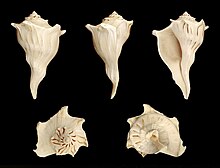Sinistrofulgur
| Sinistrofulgur | |
|---|---|

| |
| 5 views of a shell of Sinistrofulgur perversum | |
| Scientific classification | |
| Domain: | Eukaryota |
| Kingdom: | Animalia |
| Phylum: | Mollusca |
| Class: | Gastropoda |
| Subclass: | Caenogastropoda |
| Order: | Neogastropoda |
| Superfamily: | Buccinoidea |
| Family: | Busyconidae |
| Subfamily: | Busyconinae |
| Genus: | Sinistrofulgur Hollister, 1958 |
| Type species | |
| Busycon sinistrum Hollister, 1958
| |
| Species | |
|
See text | |
| Synonyms | |
|
Busycon (Sinistrofulgur) Hollister, 1958 | |
Sinistrofulgur is a genus of large sea snails with left-handed shell-coiling, marine gastropod mollusks in the subfamily Busyconinae.[1]
Taxonomy
[edit]The taxonomy of sinistral busyconids has been subject to several disputes, including at what rank to recognize them as distinct from their sister taxon, Busycon carica, and how many species are represented.
Sinistral busyconids were historically included in the genus Busycon. In 1958, Hollister proposed the subgenus Sinistrofulgur for the group.[2] Petuch elevated Sinistrofulgur to genus rank in 1994, although some other authors have continued including these snails in the genus Busycon.[3][4]
Sinistral busyconids were historically included in the species Busycon contrarium, but this name (now Sinistrofulgur contrarium) is now restricted to a small fossil species.[3] Hollister recognized four species: B. sinistrum, found between Cape Hatteras, North Carolina and the Florida Keys, as well as off the Yucatan Peninsula east of the Bay of Campeche; B. perversum, endemic to the Bay of Campeche; B. pulleyi, native to the western Gulf of Mexico from the northern coast of Mexico to Breton Sound in Louisiana; and B. aspinosum, at the time only known from Longboat Key on the gulf coast of Florida.[2] Based on genetic data, Wise et al. (2004) recognized only one extant species of sinistral busyconid, B. perversum, with three subspecies: B. perversum perversum found off the Yucatan Peninsula, B. perversum sinistrum found in the northern Gulf of Mexico, and B. perversum laeostomum found on the Atlantic coast of Florida.[3] In 2015, Petuch et al. recognized four extant species based on conchological differences: B. perversum, B. pulleyi, B. sinistrum, and B. laeostomum.[5]
Species
[edit]- Sinistrofulgur laeostomum (Kent, 1982)
- Sinistrofulgur perversum (Linnaeus, 1758)
- Sinistrofulgur pulleyi (Hollister, 1958)
- Sinistrofulgur sinistrum (Hollister, 1958)
Description
[edit]Sinistrofulgur species attain large sizes. The largest specimen reported of S. sinistrum was 375 millimetres (14.8 in) long.[2]
Human use
[edit]Artifacts made of sinistral busyconid shells are abundant in the archaeological record, and include beads, cups, gorgets, pendants, and earplugs, among other things.[4]
References
[edit]- ^ "Sinistrofulgur". WoRMS. World Register of Marine Species. Retrieved 25 October 2022.
- ^ a b c Hollister, S. C. (1958). "A review of the genus Busycon and its allies—part I". Palaeontographica Americana. 4 (28).
- ^ a b c Wise, J.; Harasewych, M. G.; Dillon, R. T. (2004). "Population divergence in the sinistral whelks of North America, with special reference to the east Florida ecotone". Marine Biology. 145: 1167–1179.
- ^ a b Kozuch, Laura; Walker, Karen J.; Marquardt, William H. (2017-09-02). "Lightning whelk natural history and a new sourcing method". Southeastern Archaeology. 36 (3): 226–240. doi:10.1080/0734578X.2017.1364959. eISSN 2168-4723. ISSN 0734-578X.
- ^ Petuch, Edward J; Myers, Robert F; Berschauer, David P (2015). The living and fossil Busycon whelks: Iconic mollusks of eastern North America. San Diego Shell Club. ISBN 978-0-578-17002-2.
